|
|
|
Sort Order |
|
|
|
Items / Page
|
|
|
|
|
|
|
| Srl | Item |
| 1 |
ID:
177798
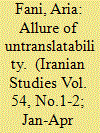

|
|
|
|
|
| Summary/Abstract |
How could one translate into any European language a Persian poem as culturally and aesthetically embedded as this hemistich by Hāfez: beh may sajjādeh rangin kon garat pir-e moghān guyad. This is the central question Mohammad-Rezā Shafiʿi-Kadkani addresses in his essay titled “On Poetic Untranslatability.” For Shafiʿi, translation is primarily a function of cultural—and not linguistic—affinity. Therefore, he argues that Hāfez’s poem is all but untranslatable in European languages given their fundamental cultural difference from Persian. This article critically engages Shafiʿi’s essay by outlining and analyzing the set of problematic assumptions embedded in its rubric of untranslatability. It places Shafiʿi’s view on translation in conversation with theorists of untranslatability in comparative literature and translation studies. Ultimately, it outlines why untranslatability is not a useful conceptual framework for the analysis of linguistic and cultural difference.
|
|
|
|
|
|
|
|
|
|
|
|
|
|
|
|
| 2 |
ID:
177802
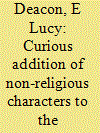

|
|
|
|
|
| Summary/Abstract |
The rule of the Qajar dynasty was a vibrant period for the Iranian taʿziyeh tradition; the genre’s anonymous dramatists not only developed the verse of the central plays of the Karbala cycle but innovated new narrative content. This study investigates one such innovation, the curious appearance of two new characters in the climactic play The Martyrdom of Imam Husain. They are the Dervish of Kabul and Sultan Qais of India, both of whom Husain encounters shortly before his martyrdom and neither of whom were previously mentioned in historical literature or religious traditions pertaining to Karbala. Through analysis of fifteen taʿziyeh renditions of Husain’s martyrdom dating from 1204/1790 to the 1950s, including rare manuscripts, this study provides a date window for the incorporation of these characters and argues that they were added to complete a trilogy of trials faced by Husain at Karbala. It also traces their literary origins and considers their social significance.
|
|
|
|
|
|
|
|
|
|
|
|
|
|
|
|
| 3 |
ID:
177800
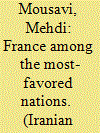

|
|
|
|
|
| Summary/Abstract |
Iran's subjection to Russo-British influence has received the bulk of attention of modern scholarship dealing with the country's interaction with the outside world in the nineteenth century. This article, while not denying the central role played by these two powers in Iran’s domestic affairs at the time, draws attention to a third power with long-standing claims to influence in the country by way of trade policies—France. From the fall of Napoleon in 1815 until the French Revolution of 1848, the French monarchy was especially keen to encourage commerce with Iran, less as a source of increased wealth than to restore and expand French prestige and political influence. This strategy became more significant, when the British and Russian superpowers opposed an active French presence in Iran and prevented France from asserting influence in the country. To contain those powers, France pursued its plan of reaching a trade treaty with Iran as a means of obtaining commercial concessions and privileges as well as to secure its permanent presence in the country. France also aimed to connect Iran to its network of regional trade extending from the Mediterranean to the Indian Ocean.
|
|
|
|
|
|
|
|
|
|
|
|
|
|
|
|
| 4 |
ID:
177799


|
|
|
|
|
| Summary/Abstract |
As a polymath in fifteenth century Central Asia, Jāmī’s (1414–92) works were widely circulated around the Muslim world. From a global perspective, Jāmī and his prose works achieved outstanding recognition in China in the seventeenth and eighteenth centuries. This paper follows the author’s previous research on the introduction of Jami’s works in China, seeking to answer the question of what it was that made Jāmī a legend in China and how this came about. By focusing on the transmission and transformation of Jāmī’s two Persian Sufi prose writings as they moved from Central Asia into China, the article concludes that two groups of people played a role as transcultural agents in this process; these were individual Sufi travelers and the Muslim intellectuals
|
|
|
|
|
|
|
|
|
|
|
|
|
|
|
|
| 5 |
ID:
177801


|
|
|
|
|
| Summary/Abstract |
Addressing the scarcity of scholarly literature on Iran’s involvement in Sub-Saharan Africa during the Pahlavi period, this paper demonstrates that throughout the 1970s, as the shah’s international standing rose and Iran’s economy grew, so too did Iran’s political and economic relationships with several African countries, especially Senegal. The article will explore a number of factors that stimulated this relationship, most significantly Senegal’s strategic and symbolic importance, and the personal friendships that developed between the countries’ leaders. The ultimate manifestation of this bilateral relationship was the Keur Farah Pahlavi project; a joint Iranian–Senegalese city to be constructed in Senegal. By exploring this project, the paper aims to demonstrate the strategies through which the Pahlavi state sought to expand its influence worldwide.
|
|
|
|
|
|
|
|
|
|
|
|
|
|
|
|
| 6 |
ID:
177803
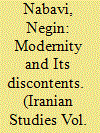

|
|
|
|
|
| Summary/Abstract |
The ratification of the Press Law in February 1908 marked a significant development in the history of censorship in Iran. However, in the little that has been written on this subject, the Press Law has been explained primarily in terms of constitutional politics, and the pressure that the first majles was put under by royalist forces who had been upset at the critical and anti-royalist tone of constitutional newspapers. This article takes a different approach; it contextualizes the Press Law and evaluates it in light of the attempts at control that had been put into effect by the state in the pre-constitutional years. To this end, this article considers the largely untold story of censorship in Qājār Iran. How did the understanding of what censorship should entail evolve through the years? How was censorship exercised, and what challenges did censorship pose for both the authorities and the subjects in the Nāseri and Mozaffari eras, culminating in the Press Law in February 1908?
|
|
|
|
|
|
|
|
|
|
|
|
|
|
|
|
| 7 |
ID:
177796
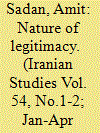

|
|
|
|
|
| Summary/Abstract |
This article examines history-writing in Safavid Iran and, in particular, the notable chronicle from the time of Shah ʿAbbas I, the Tārīkh-e ʿĀlam-ārā-ye ʿAbbāsī (TAAA). It rethinks Safavid history-writing via the perspective of environmental history. This article asks, “How was the natural world represented in the chronicle, and in what way did this representation shape the Safavid historical narrative?” It argues that the ways in which the TAAA portrays human encounters with nature suggest ʿAbbas’ unique sovereignty over it. Because of his piety and devotion, he was considered blessed with divine grace, making him the only human being with the ability to regulate natural manifestations—that is, to dominate, to manipulate, to survive, and to contain nature. Against a backdrop of an absence of environmental readings of Safavid history, the article suggests looking at the TAAA’s representation of this natural world as a powerful legitimizing force for ʿAbbas’ reign, as it is one that has not yet been foregrounded.
|
|
|
|
|
|
|
|
|
|
|
|
|
|
|
|
| 8 |
ID:
177805


|
|
|
|
|
| Summary/Abstract |
Mīrzā Ḥasan Rushdīyeh (1860(?)–1944) was a lower-ranking Azeri-Iranian cleric, constitutionalist, and educational reformer who was a major pioneer of new (jadīd) primary schools in Iran. This article shows that in 1889 Rushdīyeh, through training he had received in Beirut, introduced new schools into Iran based on changed pedagogy and modern disciplines. It argues that although the schools drew fierce opposition from maktab custodians and certain Qajar courtiers, they gradually increased in authority until the Reza Shah state appropriated them, with some modifications, as normative schooling called the dabestān. In English and Persian scholarship, we lack a substantial history of Rushdīyeh’s new schools. Drawing on previously unexamined sources, including his Iran and Ottoman diaries, this article examines Rushdīyeh’s educational work in the broader intellectual and political history of the period.
|
|
|
|
|
|
|
|
|
|
|
|
|
|
|
|
| 9 |
ID:
177810


|
|
|
|
|
| Summary/Abstract |
The word-final /-a/ and the diphthong /ay/ of earlier New Persian shift respectively to /-e/ and /ey/ in modern Persian. Isfahani Persian follows suit, e.g. dande “rib” and meydun “plaza.” However, the earlier phonemes survive only in a finite set of words: Arabic loanwords in which the /a/ succeeds pharyngeal consonants, e.g. ǰomʾa (< ǰumʿa) “Friday,” fâtaː (< fātiḥa) “funeral,” ayd (< ʿayd) “feast.” Isfahani Persian shows other vocalic anomalies adjacent to original pharyngeals, including syllable-final iʿ > aː in qânaː (< qāniʿ) “content,” maːmâr (< miʿmār) “architect.” This article investigates these phonological irregularities and their geographic distribution and historical periodization.
|
|
|
|
|
|
|
|
|
|
|
|
|
|
|
|
| 10 |
ID:
177797
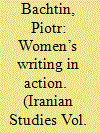

|
|
|
|
|
| Summary/Abstract |
This paper examines the textual and performative functions of early women’s writings on the example of three accounts of the pilgrimage to Mecca written during the Qajar era by Mehrmāh Khānom ʿEsmat al-Saltaneh (1880–81), the anonymous Hājiyeh Khānom ʿAlaviyeh Kermāni (1892–94), and Sakineh Soltān Vaqār al-Dowleh Esfahāni Kuchak (1899–1901). It ponders on the relationships between the female writers and textuality, their readers and, finally, the diary personas they created. It claims that their writings emerged in the process of negotiating the then existing, masculine models of textuality and authorial authority. By rejecting the monologic authoritativeness of literature and textuality, the women diarists transformed their texts into a space for dialogue—including dialogue with themselves.
|
|
|
|
|
|
|
|
|
|
|
|
|
|
|
|
| 11 |
ID:
177795


|
|
|
|
|
| Summary/Abstract |
This paper examines the notions of Shiʿism and kingship in Safavid cultural materials (coins, architectural inscriptions, enthronement orations, and panegyrics) to trace the role of Safavid ideology in the dynasty’s transformation from a Sufi order into a monarchic institution with a sectarian identity. It examines these materials in order to reconstruct the dominant ideology of the Safavids in various venues. Examination of the ideologies of Safavid rulership shows a marked difference between ideologies expressed in these cultural mediums. We argue that this difference points to a multi-pronged Safavid strategy of projecting political legitimacy in distinct registers for different audiences. By combining ideologies that were embraced and practiced by people of different regions and sects in the Persian empire before the Safavids, the Safavid monarchs managed to spread widely their power within the empire and beyond, to change the religio-political ideology of the empire, and to remain in power for more than two centuries.
|
|
|
|
|
|
|
|
|
|
|
|
|
|
|
|
|
|
|
|
|